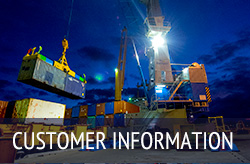Trial begins of enhanced noise reduction system
Northport is trialling a new ‘wind rose’ system to reduce the risk of noise nuisance from the port. We will use wind strength and direction to trigger warnings to stevedore companies and other port users loading or discharging from ships between 7pm and 7am.
We have used noise complaint data since mid-2015 to identify the direction from which most complaints have arisen, and the wind state at the time of each complaint. We are also revising the ‘accepted wisdom’ that higher winds carry noise more efficiently, based on research about how rough water scatters noise.
We are testing the theory that a flat, calm sea enhances noise from the port. So, in fact, noise risk increases as the wind drops and the harbour becomes calmer.
Two wind ‘sectors’ have been identified as enhancing noise nuisance from port operations. These bear between 35 degrees and 120 degrees from the port, and between 175 degrees and 280 degrees. When plotted against the points of a compass the sectors look like the petals of a rose – hence the term ‘wind rose’.
Two settings will determine the actions that we expect port users to take. At 10 knots of wind in either sector a ‘caution’ setting will require them to take measures to reduce normal noise associated with their work, and monitor wind conditions in case they reach the ‘high risk’ setting.
When the wind drops to seven knots the setting switches to ‘high risk’. Here port users must assess the need to continue operations and stop if a range of factors allow them to do so.
At three knots the light wind is considered to be ‘variable’ and therefore the setting switches to ‘high risk’ regardless of wind direction.
The wind rose will be fed constantly with real-time data from our weather instruments. It will also show how the winds have shifted over the previous eight hours. It will be available on our website from mid-July and will be monitored by our Port Services team who will alert port users when the wind is either showing in, forecasted to be in, or tracking strongly towards the risk sectors. The action required will depend on the alert setting involved.
This system will be trialled between mid-July and the end of the year, at which point we will collate and review the results.





